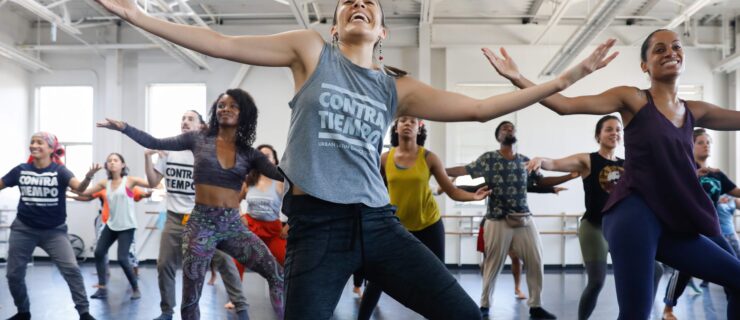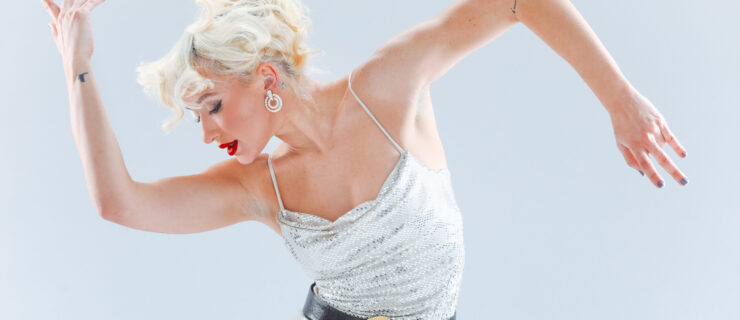Meet the Artist Behind #DancersWhoLift, a Movement to Build Strong, Confident Dancers
For the longest time, dancers were expected to be thin above all. Well-meaning dance teachers used to warn against dancers “getting too bulky.” A “serious” dancer wouldn’t dream of partaking in any other kind of sport or physical activity—let alone (gasp!) weightlifting.
But in 2019, things have—thank goodness—changed. Terms like strong, muscular, and fit now bring to mind the ideal dancer body, and it’s widely recognized that dancers are athletes as well as artists. When it comes to higher jetés, effortless extensions, and rock-solid balances, strength training is a dancer’s best friend.
Enter Dancers Who Lift, a health and fitness program that helps dancers reach their bodies’ full potential. As a professional dancer and ISSA-certified personal trainer, founder Amber Tacy understands firsthand the demands of a dancer’s non-stop lifestyle. Her platform, which includes one-on-one virtual coaching as well as free resources like her blog, email subscription, and Instagram, is designed to bridge the gap between the gym and the studio, empowering dancers with tools to live healthier and dance stronger.
Dance Spirit
caught up with Tacy to chat about DWL, cross-training, and lots more.
DS: What’s your dance and fitness background, and how did Dancers Who Lift get started?
Tacy:
I started college in Virginia as a physical therapy major, but transferred to Marymount Manhattan College and graduated in 2015 with a degree in dance science. That summer, I booked an outdoor theater gig in NYC. I soon hurt my ankle, however, and landed in physical therapy being treated myself. I ended up going so often that the clinic offered me a job! Over the next year, I worked with some of New York’s best physical therapists. But I also kept dancing, booking jobs, and having opportunities to perform. Working in the P.T. clinic wasn’t where my heart was.
I didn’t want injury to be a constant in my life. I started strength training, working with a coach, reading articles and blogs, and talking to people who were in the field. I also started the Dancers Who Lift blog, mainly because I was writing about my strength training journey on social media so much that I could feel my friends and family getting irritated! Eventually, I got my personal trainer certification and started training some of my own clients at the gym.
On the DWL blog, I wrote about connections between certain exercises and improvements in my dancing, and people I had known for years took notice. A girl I grew up dancing with commented about how I looked and danced so differently–she ended up being my first coaching client. To make things more affordable and flexible, I coached her entirely online, and created a P.T./strength training hybrid program personalized for her needs.
Over the course of four months, she got stronger, reduced her risk of injury, and ended up losing 15 pounds, which made her more confident and marketable. Through word of mouth from my friend and people reading my blog, more clients appeared. Suddenly, I had this business.
That’s how DWL was born. The blog has been going for three years now and I’ve been coaching for two online. I also just launched the DWL app, which gives me more direct access to my clients, as opposed to just emails.
No body is the same–I don’t train a modern dancer who’s doing a lot of floor work the same as I would a ballet dancer, or someone dancing on a cruise ship who needs to be working on their stability. Every workout I plan for my clients is personalized and explained thoroughly, including how it’s going to translate into their dancing.
DS: What are some misconceptions that dancers still hold about health and fitness?
Tacy:
Growing up, I didn’t have any sort of cross-training promoted to me as a dancer. There was no information other than if you were injured, you had to go to P.T. and do the exercises they give you for a few weeks until you started to feel better. Now, cross-training for dancers, particularly strength training, has turned into a movement. You can look at any sort of audition call now, and it’ll say “tumbling is a bonus,” or “looking for high-energy, athletic dancers.”
For dancers, “muscles” definitely shouldn’t feel like a bad word. Part of moving forward and progressing dance as an athletic art form is prioritizing muscles, and making sure that we do have athletic-looking dancers. Obviously, if it’s someone’s first time in a gym, you won’t throw two-hundred pounds at them. Your weights should get progressively heavier, however, meaning you’re getting progressively stronger, until eventually, maybe you are picking up two-hundred pounds.
 Amber Tacy, courtesy Theik Smith Photography
Amber Tacy, courtesy Theik Smith Photography
DS: How can dancers tell the difference between factual fitness information and fads, especially on social media?
Tacy:
We know a lot more than we give ourselves credit for. Most of us have spent decades honing in on our craft. We know that person didn’t get their developpé a la seconde to their ear overnight. It was day after day of showing up at the barre, getting warm, and getting their leg one inch higher. The same is true with your strength training. It’s about showing up, practicing, and being diligent, patient, and kind to yourself. There are days when you can show up to a ballet class and fall out of every single turn–that doesn’t make you a bad dancer or person, it just means you weren’t on your leg that day. The same is true in the gym: You show up and you won’t always feel your strongest, or you’re out with friends and you won’t always choose the best meal for your goals, but you move past it, and look at yourself with empathy and excitement. You’re not going to lose or gain weight overnight. It’s about showing up and channeling that diligence that we’ve been taught as dancers.
My philosophy is, I want to give away as much free information as I can. I wish there was more available when I was younger, so I find that it’s my responsibility to put out honest, factual content that’s easy to understand and to put into practice. Knowledge is power, and I want more dancers to feel powerful in the gym, when they’re making nutritional choices, and when they step into an audition or onstage.
DS: What advice do you have for dancers to build a positive body image?
Tacy:
That’s such a heavy conversation, and I have it with my clients a lot. We’re totally right to say “love your body,” “be body positive,” and “show up in your skin,” but unfortunately our industry is not where we are as a society yet. Part of that is knowing you signed up to be in this industry, and as a result, someone else may have the right to dictate how you look for a particular job or part. If you don’t align with that, maybe it’s not the role for you. We have to remove ourselves emotionally from that and look at it logically. For example, I’m 5 feet tall, so I’m never going to be a Rockette. It doesn’t make me a bad dancer, or make the casting director someone who hates me—I’m just not a Rockette build.
You can also look at it from a health standpoint and ask, “Am I going to be able to keep up with the athletic demands of where dance is headed?” It’s much better to look at your body as simply the carriage for your performer self. Instead of wanting to look a certain way, think of what you want as a dancer, such as getting through a three-hour show, having longevity in your career and less injury–or even just less frequent soreness. Those are all things I’ve worked with dancers for.
One thing that I preach is you have to be 100% in love with who you are every time that you step onstage or into an audition. It’s wonderful through strength training to watch everyone find themselves in that way. There is something that clicks when my clients lift something super heavy, like one-hundred pounds for the first time after starting with a fifteen-pound dumbbell. As we pass these milestones, confidence grows and people really step into themselves. It’s a beautiful growth process to watch and be a part of. On one hand, it’s about lifting weights, but as Dancers Who Lift, it’s also our responsibility to lift up each other, and elevate the dance community as a whole.




